Deciphering the Codes Hidden in Napoleon's Talisman
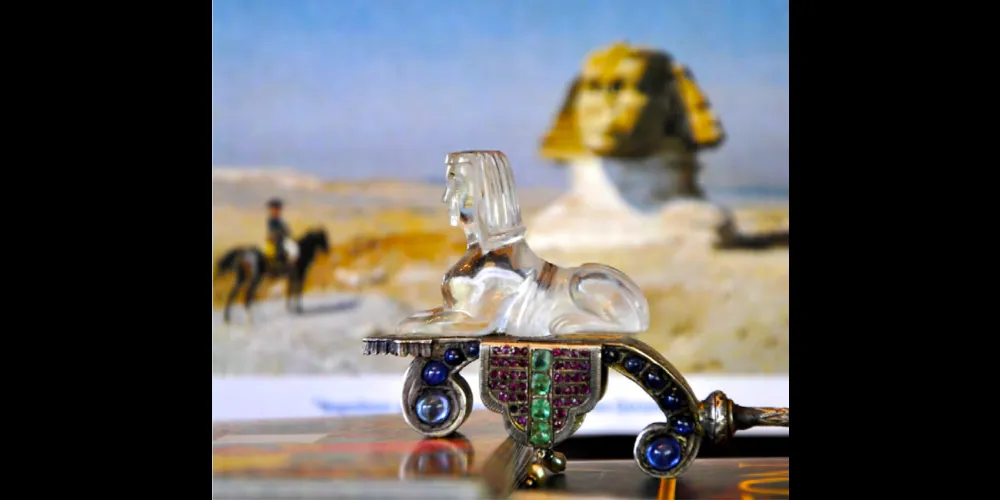
Written January 18, 2023.
>>Japanese page of this article
In this article, we decipher and examine the codes hidden in Napoleon's talismans that are not in G. Randall Jensen's report.
Mr. Jensen investigated and deciphered part of the code and deduced that this talisman belonged to Napoleon.
However, "Napoleon's Talisman" has a deep mystery, and I discovered that there is a "hidden code (a strange match of numbers)" that is not mentioned in Mr. Jensen's report.
I will explain the "hidden code" while introducing some of Jensen's research.
However, the interpretation and consideration are based on the premise that this talisman belongs to Napoleon, so please read it with that in mind.
It is up to you to believe or not that this talisman belongs to Napoleon.
Perhaps in the future, we may discover a record about this talisman or an episode about Napoleon.
Jensen's research report is distributed on this page.
If you want to know the outline of "The Talisman of Napoleon Bonaparte", please refer to this page.
Those mentioned in Jensen's report are noted as such. Other items are based on my own considerations.
All images in this article are from G. Randall Jensen's report "The Talisman of Napoleon Bonaparte" and have been processed with clear explanations.
Reference:G. Randall Jensen's report "The Talisman of Napoleon Bonaparte" distributed by Auction Company of America HP
0、Structure of the Napoleon's Talisman
Placement and number of gems
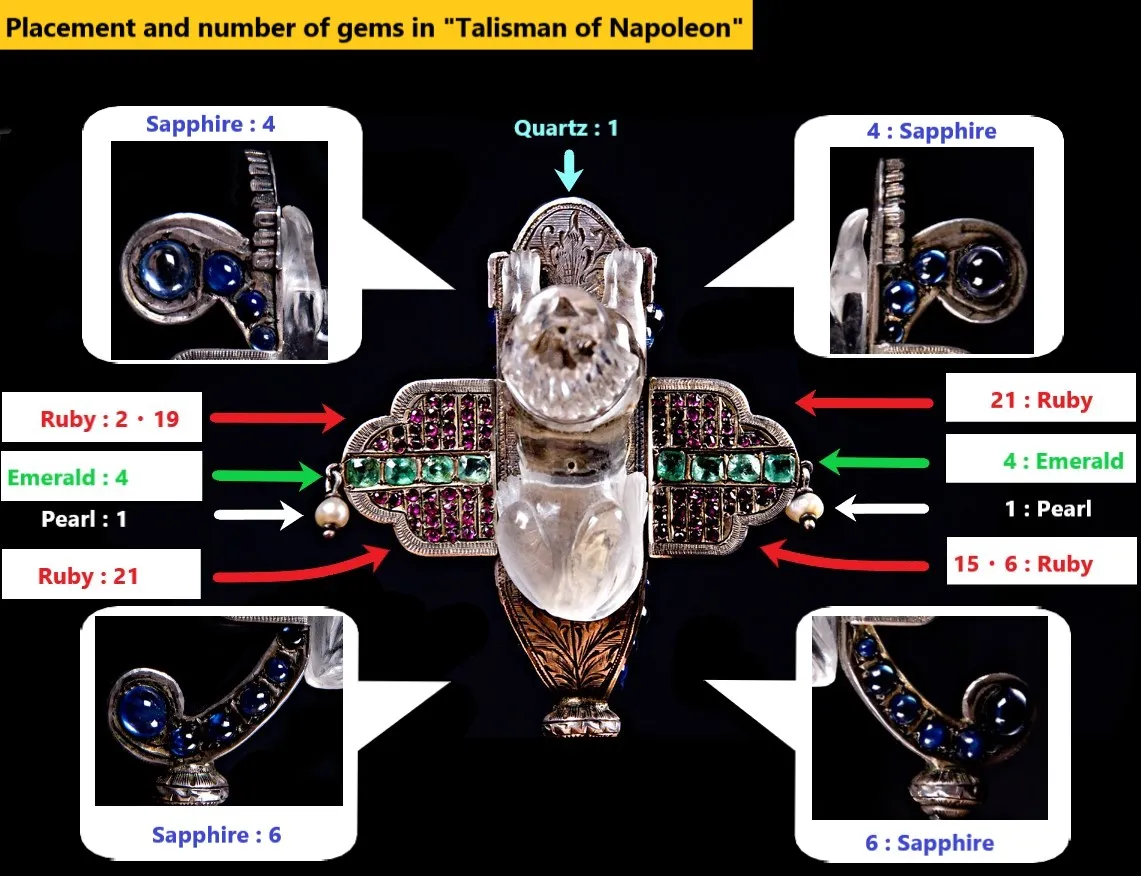
Back of talisman
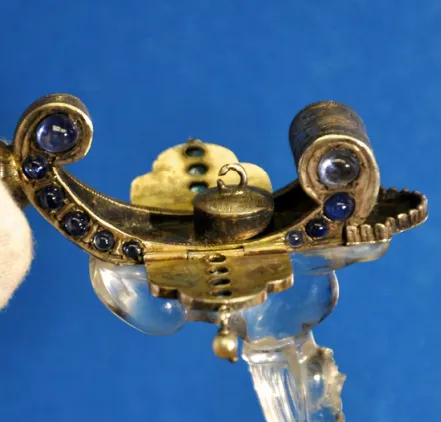
You can see that "8" emeralds can be seen from the back side as well.
1、Napoleon "114+1" and Josephine "1+92"
"114+1" indicating Napoleon
The total number of jewels in "Napoleon's Talisman", excluding the Sphinx, is 84 rubies, 20 sapphires, 8 emeralds, 2 pearls, and 1 crystal, for a total of 114.
If we add the sphinx (Josephine) to it, we can express it as 114 gemstones + 1 crystal quartz sphinx.
If you express "114+1" as "1+14+1", you can think of it as "14+2".
Napoleon's initial "N" is the 14th letter in the alphabet and Bonaparte's initial "B" is the 2nd letter.
This is described in Jensen's report "The Talisman of Napoleon Bonaparte".
"1+92" indicating Josephine
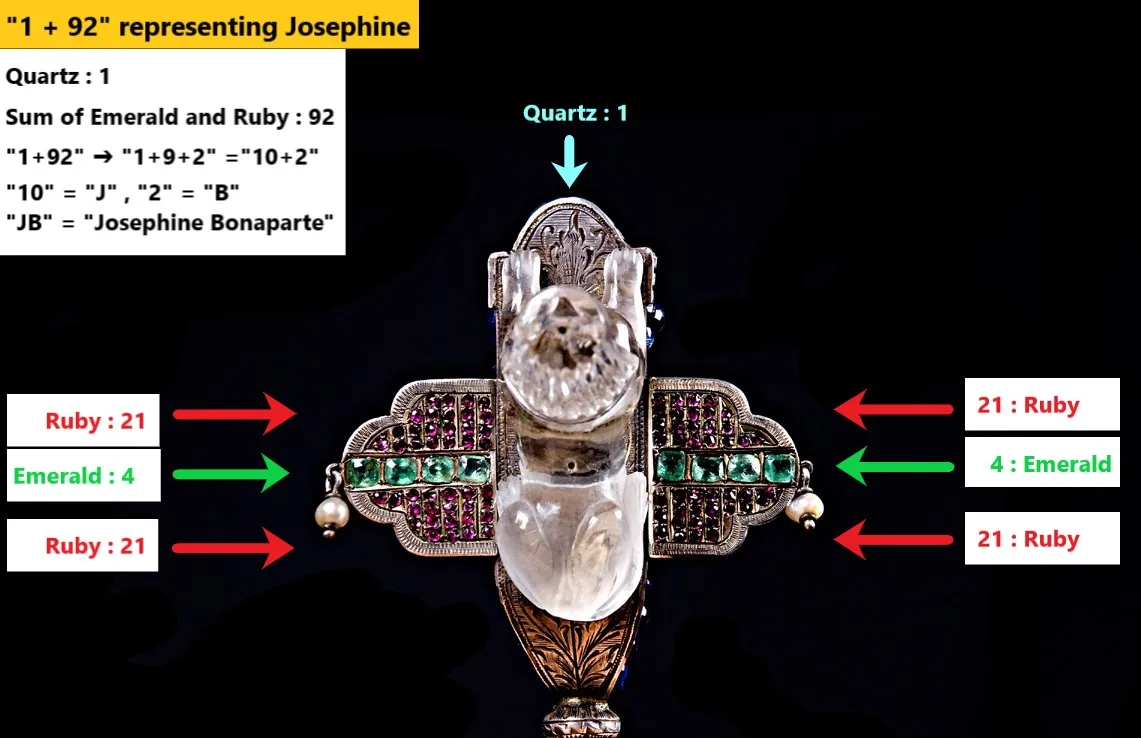
Where did the number "92" come from? It is the number of jewels set in the panels on either side of the Sphinx.
There are 84 rubies and 8 emeralds, for a total of 92 gemstones.
Adding the sphinx to it, it can be described as one crystal sphinx + 92 gemstones fitted into the panel.
Reading "1 + 92" as we did for "114 + 1," we get "1 + 9 + 2," which can be thought of as "10 + 2."
Napoleon's wife Josephine's initials "J" are the "10th" letter in the alphabet, while Bonaparte's initials "B" are the "2nd" letter.
The key to this hidden code is "92," and "92" must have been a very important number to Napoleon.
Finding "92" was relatively easy because Napoleon, a math lover and Josephine lover, expected that if he were to cipher himself and Josephine, he would use "109" or "92".
2、The important number "92" for Napoleon
Meaning of "92"
In conclusion, we can assume that the number "92" represents the fusion of Napoleon and Josephine.
Napoleon's birthday is August 15, 1769; Josephine's is June 23, 1763.
The total number of the last two digits of Napoleon's birth year, 1769, "69" + birth month "8" + date of birth "15" is 92.
And the total number of Josephine's birth year, 1763, with the last two digits "63" + birth month "6" + date of birth "23" is also 92.
In this number "92" Napoleon and Josephine are fused together.
Rationale for considering that "92" represents the fusion of Napoleon and Josephine.
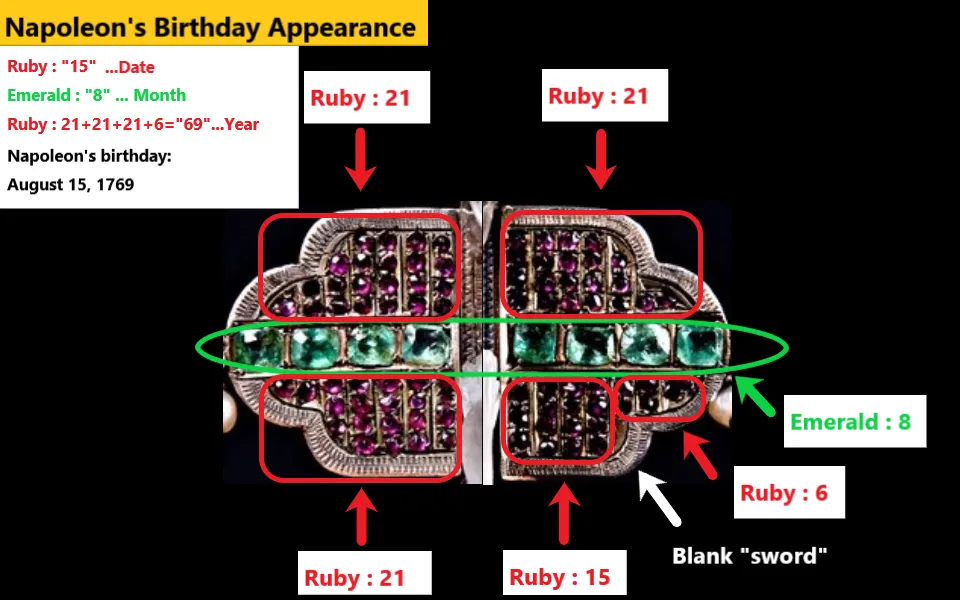
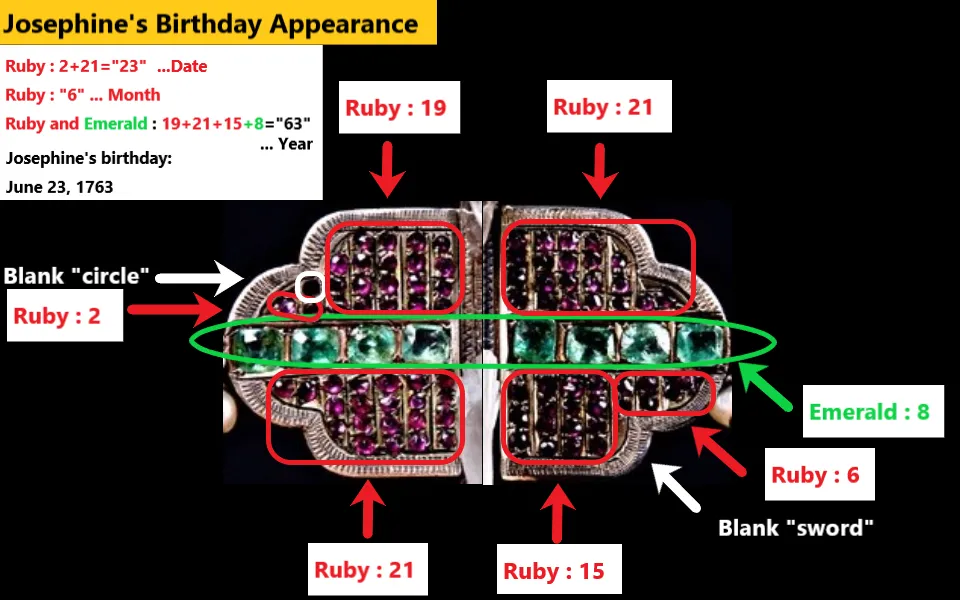
Subtracting the total number of Josephine's birthdays "92" from the total number of Napoleon's birthdays "92" yields "0".
The "21" ruby fitted on the front side of the left panel of the Sphinx has a "22" round hole, which is hollow.
Jensen's report points out that this void represents a "0," indicating that a "Tarot cord" is hidden because tarot cards are composed of "22" cards, including "0."
And there is no round hole but a blank space between the "21" rubies fitted on the rear side of the panel to the right of the Sphinx.
This blank may represent a "sword" due to its shape.
The card with the "sword" in the Major Arcana of the Tarot card is 8: Justice.
And "sword" is also a symbol of "phallic".
Since the "circle" symbolizes a woman, the blank in the left panel is the blank representing a woman (Josephine), and the blank in the right panel is the blank representing a man (Napoleon).
The possible cards for the "circle" in the Major Arcana of the Tarot cards are 0: The Fool and 10: The Wheel of Fortune.
Counting the rubies clockwise between the "male (Napoleon)" and "female (Josephine)" blanks yields "38," and dividing "38" between the right and left panels yields "15" on the right and "23" on the left, indicating the dates of birth of Napoleon and Josephine.
Next, the emerald in the center of both panels is "4" on the right and "4" on the left, for a total of "8", and Napoleon's birth month appears.
The "84" rubies are divided into anterior and posterior by the emerald.A "6" ruby is fitted between the rear of the "4" emeralds and the "Male (Napoleon)" blank in the right panel.
"6" is Josephine's birth month.
Finally, counting the number of gems remaining on each side, the number remaining on Napoleon's side is "69" and the number remaining on Josephine's side is "63," revealing the birth years of Napoleon and Josephine.
I think I could explain all the blank spaces and the number of gems fitted into the panels.
Taken together, we can consider that the panels on either side of the Sphinx represent the fusion of Napoleon and Josephine.
3、NB" and "JB" appearing in others
The numbers "14 + 2 (NB)" for Napoleon and "10 + 2 (JB)" for Josephine, introduced in 1, also appear in other parts.
"10 + 2" (Josephine's initials "JB")
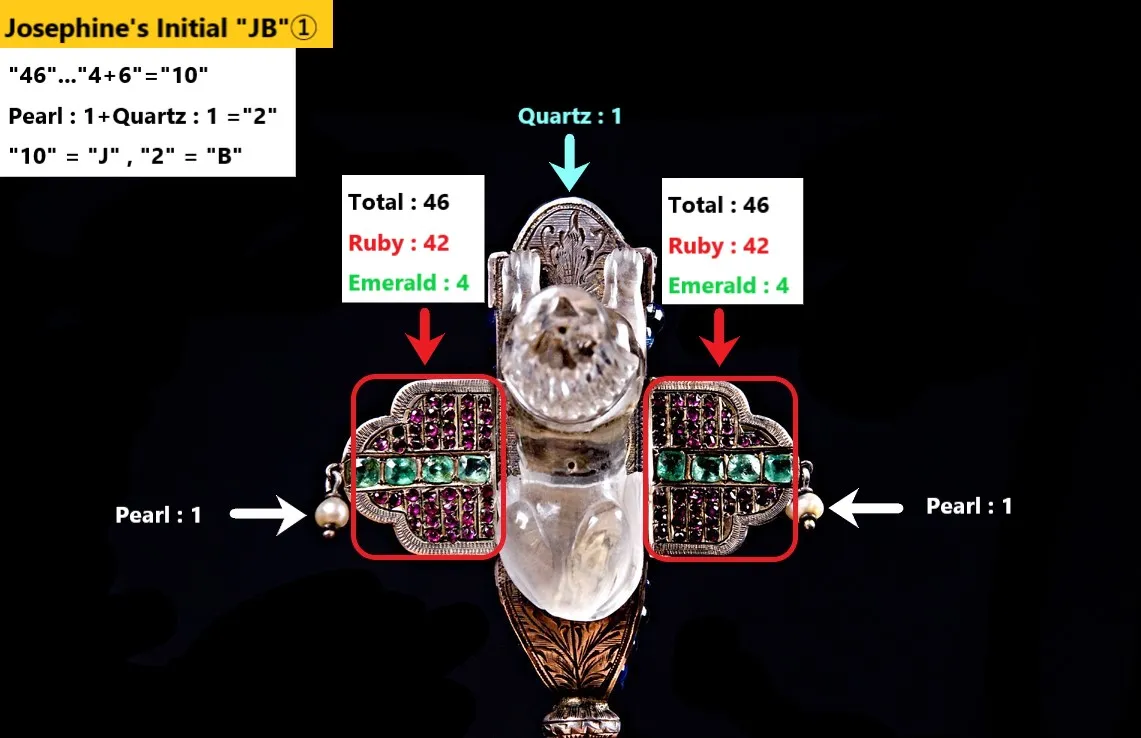
"1" pearl on the left + "46" total gems on the left panel + "1" sphinx.
Sphinx "1" piece + total of "46" gems on the right panel + "1" pearl on the right.
These are "1" + "10" + "1" and can be thought of as "10 + 2".
The "10 + 2" represents Josephine as before.
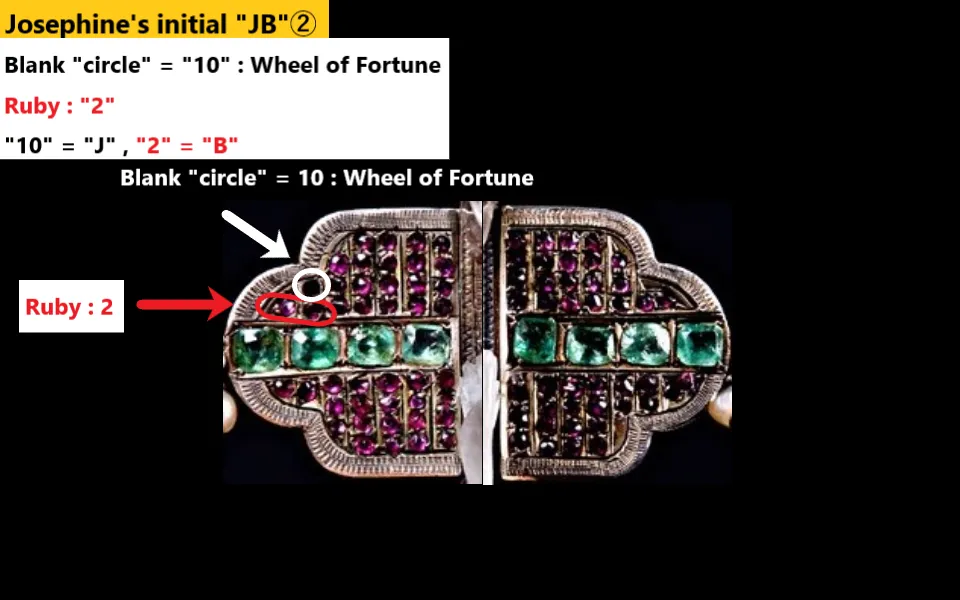
Next, assuming that the blank representing the "circle" is "10: Wheel of Fortune", there are "2" rubies outside of it, so "JB (Josephine)" appears here as well.
"14 + 2" (Napoleon's initials "NB")
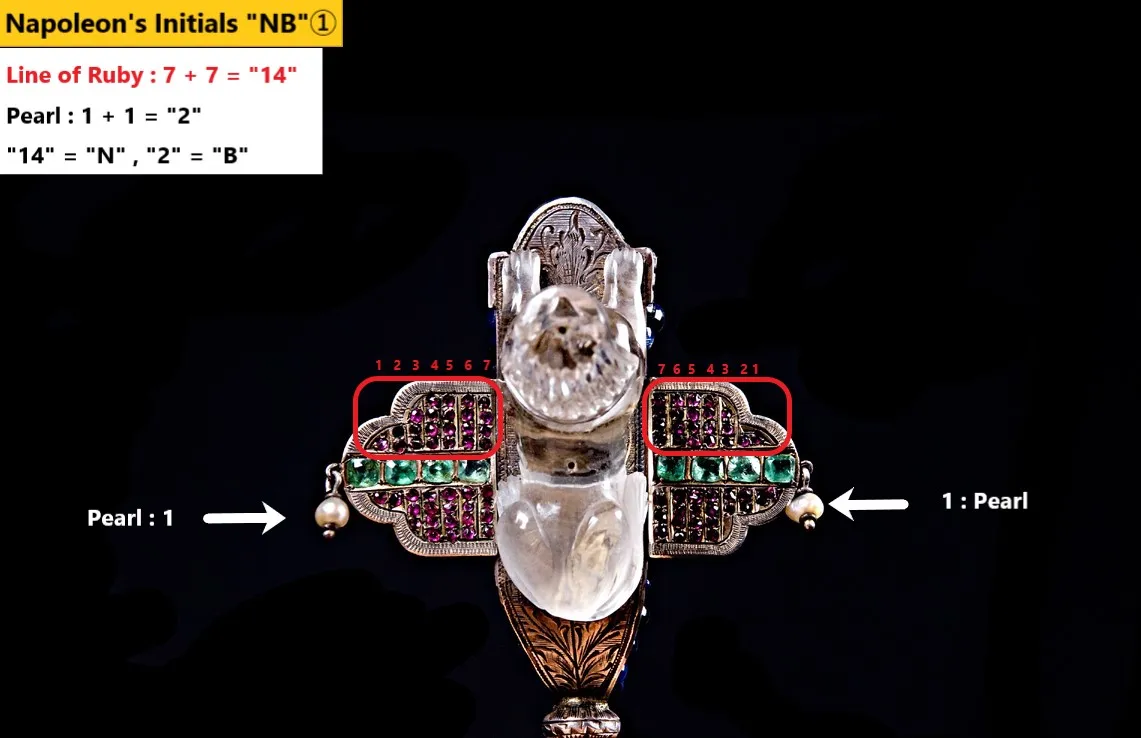
The line of rubies in the front of both panels is "7" on the left and "7" on the right for a total of "14", and the pearls hanging at the ends of both panels are "1" on the left and "1" on the right for a total of "2".
The "14+2" represents Napoleon as before.
Since this is visible from the front, it may correspond to the hidden "JB" in front of the sphinx in Jensen's report.
Since the cipher indicating Josephine is in front of the Sphinx and the cipher indicating Napoleon is on a panel on the side of the Sphinx's body, this too could indicate that the front of the Sphinx (head) indicates Josephine and the back of the Sphinx (body) indicates Napoleon.
The Sphinx is said to have a human head and a lion's body, for Napoleon is said to have said that his name indicated a "lion of the desert".
Napoleon may have said so because "Napoleon" contains "Leon" (ancient Greek) or "Leo" (Latin).
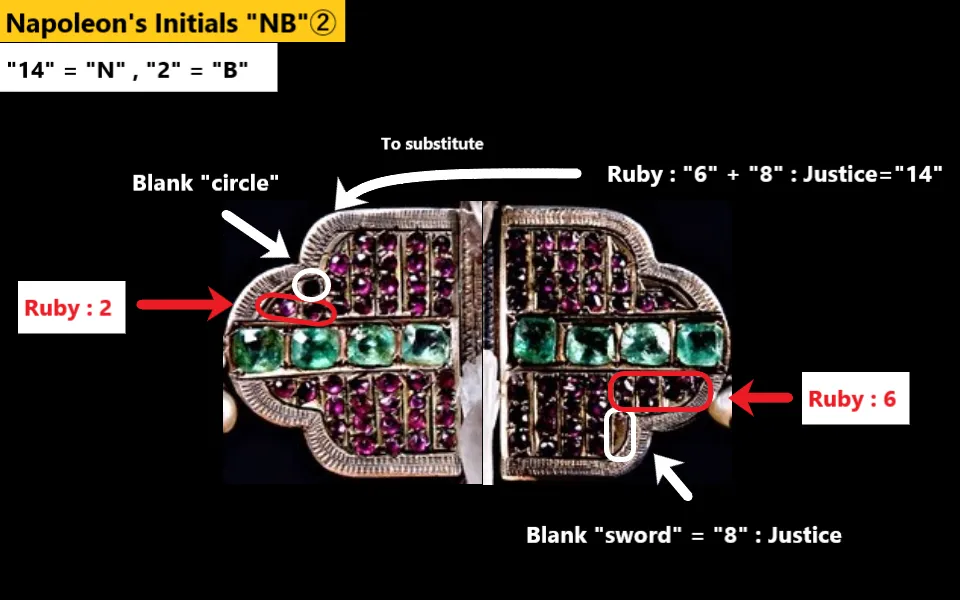
Next, assuming that the blank that could represent the "sword" is "8: Justice", there are "6" rubies outside of it, and "8" + "6" = "14".
Substituting "14 (Napoleon)" into the cavity representing the "circle" (combined with Josephine) yields "14" and "2" (outer ruby), where "NB (Napoleon)" also appears.
4、Other considerations about Napoleon's birthday that appear
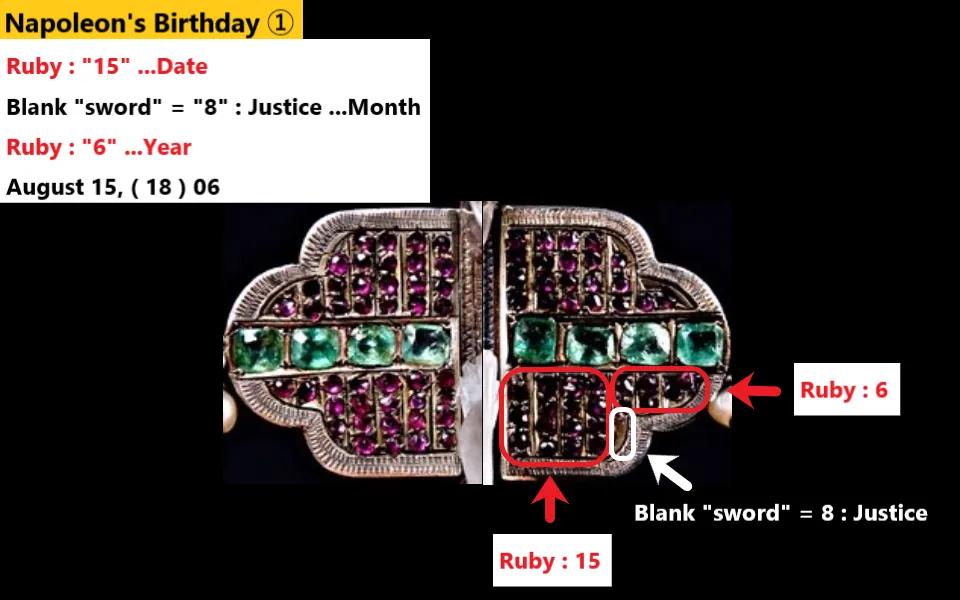
In #3, we pointed out that the line of rubies in the front of the panel hides an "N", but it is possible that Napoleon's birthday is also hidden in the rubies in the rear of the right panel.
Assuming the blank of the "sword" to be "8:Justice," the ruby outside of it would be "6" and the ruby inside of it would be "15," thus revealing August 15, 1806.
His birthday in 1806 was his first after his victory at the "Battle of Austerlitz," a time when he had been emperor for almost two years and wanted a direct heir to Josephine.
Similarly, assuming that the "circle" blank in the left panel is "10: Wheel of Fate," the ruby outside of it is "2" and the ruby inside of it is "19," so October 19, 1802 appears.
Possibly some event occurred on this date.
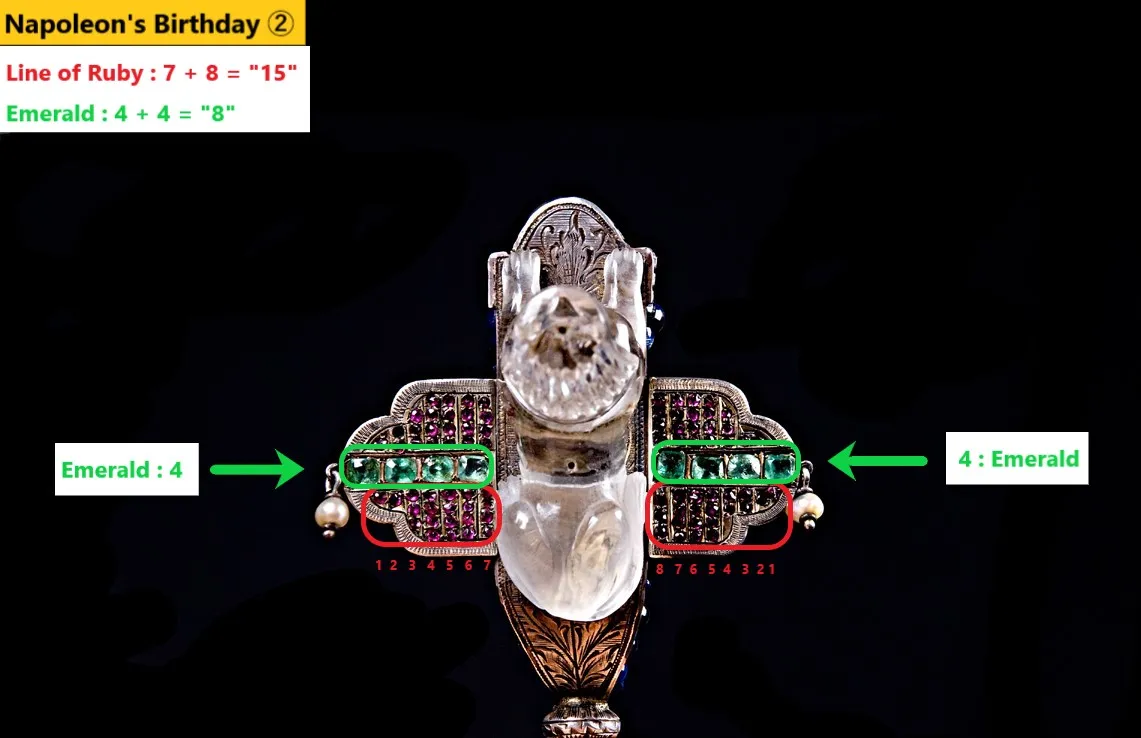
The Emerald line in the center of both panels and the Ruby line in the rear may also conceal a cipher.
The Emerald line in the center has "4" on the left panel and "4" on the right panel for a total of "8" and the month of Napoleon's birth, while the Ruby line in the back has "7" on the left panel and "8" on the right panel for a total of "15" and the date of Napoleon's birth.
If we also add to this the Pearl line left "1" and right "1" for a total of "2", we get August 15, 1802.
Adding four lines of sapphires to the pearls gives six lines, which can be considered to indicate August 15, 1806.
His birthday in 1806 was his first birthday after his victory at the "Battle of Austerlitz" as explained earlier, a time when he and Josephine wanted a direct heir.
If these allude to Napoleon's birthday in a given year, then there is something more definitive.
4、Hidden Tarot Codes
Many numbers appear in the Napoleon's Talisman, and they are associated with tarot cards.
Tarot cards are numbered 0 through 21, for a total of 22 cards.
Point made by G. Randall Jensen in his report
The cavity in the left panel is an intentionally created cavity and represents "0: The Fool" and is the "key" indicating that the "Tarot Cords" is hidden.
The two pearls represent "2: Wisdom/The High Priestess," and other hidden tarot cards are "3: The Empress," "4: The Emperor," "6: The Lovers," "7: Victory/The Chariot," "8: Justice" and "10: Wheel of Fortune.
"3: The Empress" is repeated four times in the Ruby line, and "4: The Emperor" is repeated "15" times in the Ruby line, "4" times in the Emerald line (front and back), and "2" times in the Sapphire line, for a total of "21" times.
And the whole piece is composed of six materials: emerald, ruby, sapphire, pearl, silver, and quartz crystal, where the "6: The Lovers" appears.
And since "6" sapphires are inlaid at the rear of each side, "6: The Lovers" is repeated a total of "3" times.
For "7: Victory/Chariot," there are three places with seven rows of rubies; for "8: Justice," there are eight rows of rubies on each panel of the Sphinx; and for "10: Wheel of Destiny," there are "10" sapphires inlaid on each side of the Sphinx's base.
Jensen's report notes the above.
Numbers that may be "Tarot Cords" not noted in G. Randall Jensen's report
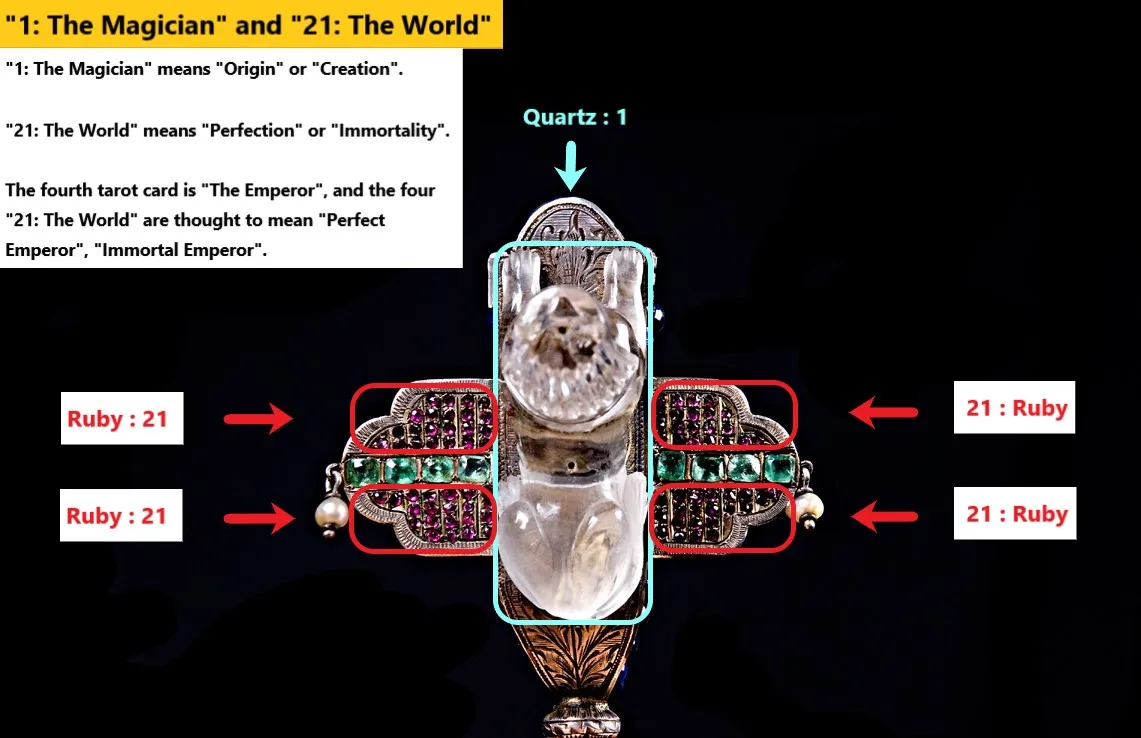
1、"1: The Magician"
The crystal sphinx is "1" piece and may represent "1: The Magician".
"1: Magician" means "origin" or "creation."
2、"21: The World"
For "21: The World", both panels have "21" rubies repeated "4" times.
Since "21: World" means "perfect" or "immortal," and the 4 represents "4: Emperor," it could mean "perfect emperor" or "immortal emperor.
Since "4: Emperor" is also repeated 21 times, it is thought to emphasize the "perfect emperor" or "immortal emperor."
Lastly
The time spent contemplating the hidden codes was a lot of fun.
Whether or not this talisman belongs to Napoleon, we are grateful to Mr. Jensen for his discovery and publication.
Mr. Jensen speculates that this talisman was completed around the time of Napoleon's first birthday (August 15, 1802) after becoming consul for life.
However, my impression is that Napoleon's Talisman was created with the hope that after he became emperor, he would have a son with Josephine and that the Napoleon Empire would be stabilized.
Maybe there is some other hidden code besides these.
Why don't you try to decipher it too?
I think the odds of it being anything other than Napoleon's are low, but it might be interesting to decipher it under the assumption that it belongs to a specific person other than Napoleon.
Reference material
「The Talisman of Napoleon Bonaparte」 G. Randall Jensen
